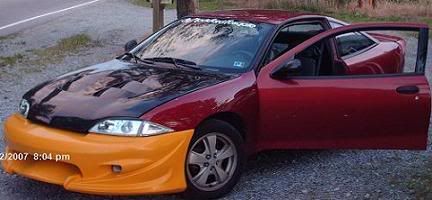How To: Racing Seat Brackets
Well here it is, since I FINALLY got around to doing my racing seat brackets for the seats I bought from Jason way back in November 05, I decided to get my ass in gear and get the brackets done.
I also took a bunch of pictures of the process I used. Please note, this is NOT the only approach to making brackets, this is just how I did it.
PLEASE NOTE THE FOLLOWING DISCLAIMER!!!!!
These are NOT meant to be street legal. They are NOT meant to be a life saving device. Remember, if you skimp out on the parts, you CAN ENDANGER YOUR LIFE. Buy quality stuff for these brackets, each one cost me about $20 in parts or so.
I will also NOT be giving you measurements. Why? Because if I do, you'll go blindly making these brackets without test fitting, measuring, and measuring again before completely doing the brackets. Then, when they don't fit, you'll be pissed. This is a lesson in using a little bit of the melon that sits so nicely on your shoulders, so fire it up.
MATERIALS (Per Bracket)
(2) 32" 1/4 Inch Thick Flat Bar Weldable Steel
(1) 32" 1" Square Stock (You can use the stuff with holes like I did)
(10) Grade 8 1.5" 5/16ths Bolts
(2) 1" 5/16ths Grade 8 Bolts
(12) 5/16ths Locking Nuts
 Step 1: Remove your stock seats
Step 1: Remove your stock seats
Well this is pretty simple, so if you can't figure it out, without me holding your hand, then you shouldn't be attempting to make brackets. I'll give you a hint though, there is a bolt at each corner where the seat meets the floor.
 Step 2: Create cross bars
Step 2: Create cross bars
Cut one of the pieces of 1/4 inch thick flat stock a little wider than the two rear bolts, as you can see in the pic above. Then do the same for the front one, don't cut it too much wider than it needs to be to get the bolts on. You'll want to measure out where you need to drill for the bolts, and do a test fit to make sure it goes on. Mine didn't the first time and I just needed to round out the holes a little bit in order for it to slip on.
 Step 3: Create Support Bars
Step 3: Create Support Bars
For this one, I took the 36" bar and cut it directly in half. This allowed me to be able to mount the seat back far enough that I had some leg room. The first pic that you see up there I didn't cut the brackets long enough, and therefore couldn't move the seats back far enough to keep my knees from hitting the dash (and I'm only 5'10"). You'll see pics later of how to mount them to the seat...
Anyway, as you can see in the picture, you need to line them up, so they are running front to back. You want to keep them spaced as far apart as possible without getting in the way of the seat bolts. MAKE SURE to very CAREFULLY, using a machinists square, to get the bars running parallel and straight, then mark them off. Not being carefull with this will cause your seats to sit cockeyed later down the road.
 Step 4: Bolt Support Bars To Cross Bars
Step 4: Bolt Support Bars To Cross Bars
Just be careful, mark the holes where the cross bars go and drill through the cross bars. Bolt them up, but not too tight. Use the longer 1.5" grade 8 bolts to do this one, and make sure the nuts are on the top.
Now go back out to the car and do this:

Then tighten the bolts down as far as you can, so it doesn't distort when you take it off. Please note however, your's won't look like mine, you're brackets will stick out the back more. I have mine so the tube stock is lined up with the front one, and extends out past the rear crossbar, you'll see it in the pics below...
 Step 5: Create cross bars for the seat bolts
Step 5: Create cross bars for the seat bolts
Its difficult to see because I didn't get a picture of it, but the concept is simple, take the other piece of flats stock that you have, and cut it into two bars that extend from one side to the other for the seat, and bolt them down. Just make sure to get these bars straight so your seat sits straight when you are done.
Step 6: Get Seat Placement Correct
I don't have a picture for this, but what you do, is put the bracket that you've made in the car and bolt it down. Then take the seat, with the cross bars bolted on, and place it on top of the bracket that you've made. You need to mark how far to the left or right the seat sits on the bracket, so make sure the seat is sitting straight. Its extremely difficult, but you need to mark where the seats are sitting so when you take it out you can drill holes. Climb under the seat and mark where the square tubing goes across the crossbars on the seat. Trick is doing this without moving the seat after you position it. Make sure you can close the door without the seat interfering with the door.
 Step 7: Line Bracket up to seats and mark holes to drill
Step 7: Line Bracket up to seats and mark holes to drill
This is simple in concept, but gets a bit tricky. Take both the seat and the bracket back out, flip the seat up side down, and clamp the bracket on to the bottom of the seat in the position that you had it marked. MAKE SURE that the brackets are exactly the way they were in the car, remember its upside down now. You need to mark (pencil works best) where the holes cross the crossbar on the seats so you can drill holes to put the bolts through.
FINISHED PRODUCT


These are the brackets after I got them done. You can see on the side that I used long bolts with a whole load of washers, this is because I used 1/8th inch flatstock and the first time I sat in it the bars bent (need to lose some wieght), but even if you are skinny, the first couple bumps you go over would have bent them anyway. The 1/4" flat stock should help solve the bending issue and should be able to support the wieght.
Here is the seat bolted in to the car, it was night, so excuse the crappy pics:




Feel free to ask questions!
 4cyltuner.com
4cyltuner.com - Information Source For 4 Cylinder Tuners
Buy stuff from CarCustoms Ebay! Won't be disappointed!































